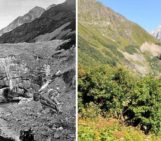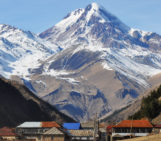![Aerial image showing the climate change impact on small glaciers in the central Greater Caucasus, Georgia. Slopes are extensive deposits of moraines and loose rock debris, left behind by retreating glaciers. A small glacial lake (near the center-bottom of the image) fed by meltwater from the surrounding ice and snow was developed after glacier retreat [Credit: Levan Tielidze].](https://blogs.egu.eu/divisions/cr/files/2025/06/Fig0-700x400.jpg)
In this week’s blog, Levan Tielidze tells us about his recent glacier study from the Greater Caucasus. By combining geomorphology, remote sensing, and historical cartography, the team reconstructed nearly 200 years of glacier and climate change across one of the world’s most dynamic cryospheric frontiers. Glaciers’ transformation provides a high-resolution archive of post-Little Ice Age climate dynamics in this region where instrumental records are sparse.
The Greater Caucasus and the Little Ice Age
The majestic Greater Caucasus mountains, a rugged spine separating Europe and Asia, are not just a haven for breathtaking landscapes; they are also home to more than a thousand glaciers. These icy sentinels are more than just frozen water; they are vital freshwater reservoirs, crucial for the rivers, ecosystems, and communities that depend on them. But like their counterparts worldwide, these glaciers are in retreat, and our recent study has delved deep into their past to understand just how dramatically they’ve changed since the Little Ice Age (LIA).
The LIA, a period of cooler global temperatures that ended around the early to mid-19th century, saw glaciers expand. But what happened after? Our team focused on twelve small glaciers nestled on both the northern (Russian) and southern (Georgian) slopes of the central Greater Caucasus to find out (Figure 1).

Figure 1: Map of the Greater Caucasus, illustrating regional divisions and the extent of glaciers in 2020 (blue). Selected glaciers are shown with yellow dots [Credit: Tielidze et al., 2025].
Why Small Glaciers Matter
Small glaciers react faster to climate change than their larger counterparts. Their simpler geometry and well-preserved moraines make them excellent candidates for reconstructing past snowlines and climate conditions. For the Greater Caucasus, where glaciological research has often been hindered by terrain, politics, and patchy data, they also offer a rare, consistent window into past environmental change.
Using high-resolution satellite imagery (including PlanetScope and Google Earth), historical maps from the 19th and 20th centuries, and different digital elevation models, we traced glacier extent, snowline elevations, and terminus positions from the 1820s through to 2020.
A 200-Year Story of Retreat
The results are sobering. Since the 1820s, the total area of the twelve studied glaciers has declined by nearly 50%. The average annual area loss accelerated markedly in the second half of the 20th century. Between 1960 and 2020 alone, glacier area shrank by over 35%.
Terminus positions also retreated dramatically. On average, the glaciers’ snouts moved uphill by 1278 m over the last two centuries, with 576 m (45%) of that retreat occurring in the last 60 years alone.
Reconstructing Climate from Ice
What sets this study apart is its use of glacial geometry to estimate past temperatures in the absence of dense instrumental data. By combining reconstructed ELAs with a regional temperature lapse rate (~6.0 °C per km), our team derived temperature anomalies for each glacier (Figure 2). Our reconstruction aligns well with other proxies in the region, including ice-core records from Mt. Elbrus and instrumental records from Mestia meteorological station, western Georgia.
The reconstructed climate findings from the study indicate significant Equilibrium Line Altitude (ELA—the elevation where annual snow accumulation equals melt) upward shift. ELAs rose by an average of 180 m since the LIA maximum in the 1820s, reflecting a mean warming of about 1.1 ± 0.3 °C in the region. The steepest warming and ELA rise occurred post-1960, with snowlines increasing by 105 meters and temperatures by 0.6 ± 0.3 °C. These findings highlight accelerated glacier retreat driven by post-industrial climate warming
This convergence of independent data sources underscores the robustness of glacier-based climate reconstruction in mountain regions.

Figure 2: Animation showing the reconstructed glacier geometry, ELA, and corresponding temperatures relative to the present in 1820, 1890, 1960 and 2020, for one of the selected glaciers in the Greater Caucasus [Credit: Levan Tielidze].
Implications Beyond the Caucasus
While the focus of this research is regional, the study’s implications are global. Mountain glaciers—small, remote, and often overlooked—are disappearing fast. The Greater Caucasus has already lost over 23 % of its glacier area since 2000 (Tielidze et al., 2022), a decline mirrored in many other high-mountain regions. These losses threaten not only regional water supplies and ecosystems but also amplify risks from glacial lake outburst floods and landslides.
Our work provides a critical baseline for understanding how these glaciers responded to pre-industrial climate variability, offering essential context for what lies ahead.
Edited by Florida Schalamon & Emma Pearce
Further Reading
- Tielidze, L. G., Mackintosh, A. N., Gavashelishvili, A., Gadrani, L., Nadaraia, A., and Elashvili, M. (2025). Post-Little Ice Age Equilibrium-Line Altitude and Temperature Changes in the Greater Caucasus Based on Small Glaciers. Remote Sensing, 17(9), 1486.
- Tielidze, L. G., Nosenko, G. A., Khromova, T. E., and Paul, F. (2022). Strong acceleration of glacier area loss in the Greater Caucasus between 2000 and 2020, The Cryosphere, 16, 489–504
- Tielidze, L. G., Jomelli, V., and Nosenko, G. A. (2022). Analysis of Regional Changes in Geodetic Mass Balance for All Caucasus Glaciers over the Past Two Decades. Atmosphere, 13, 256




